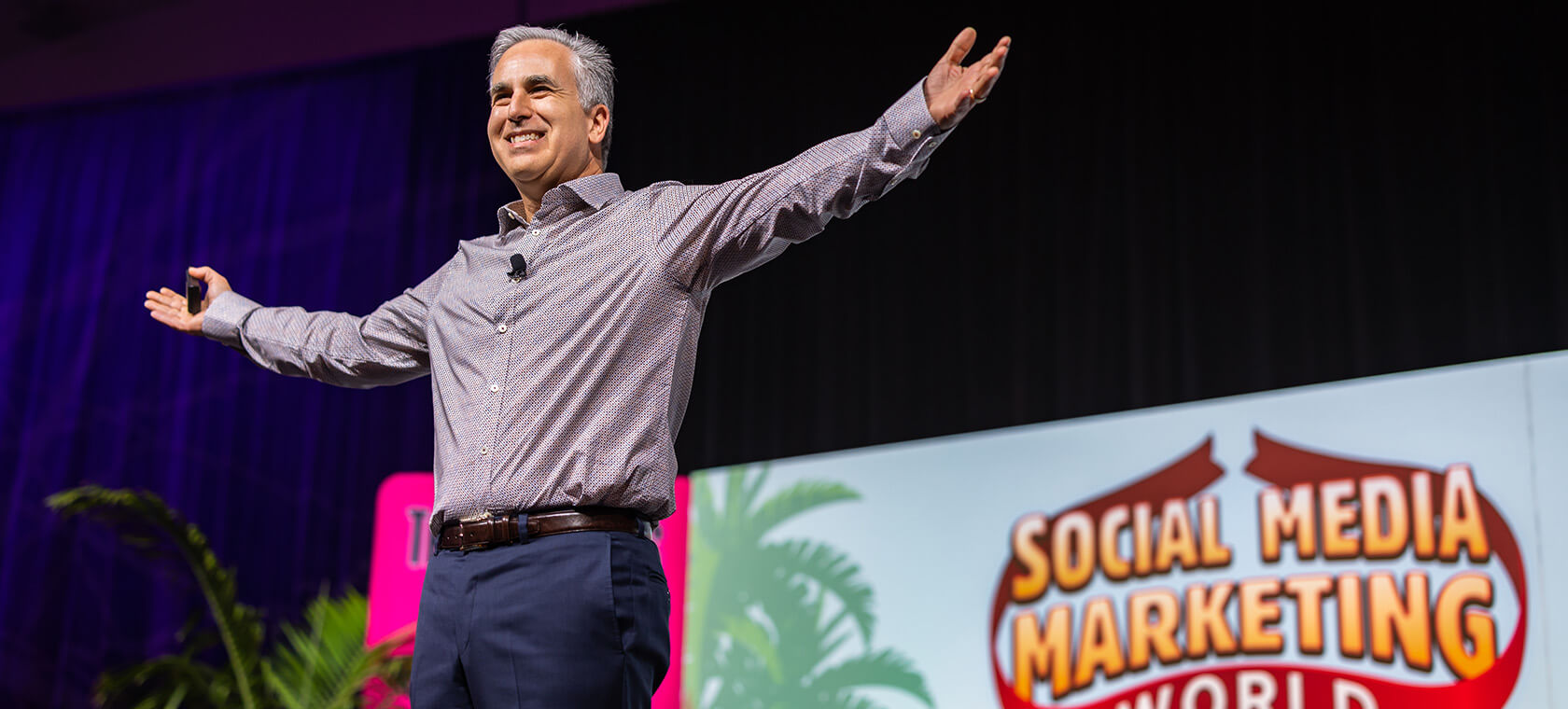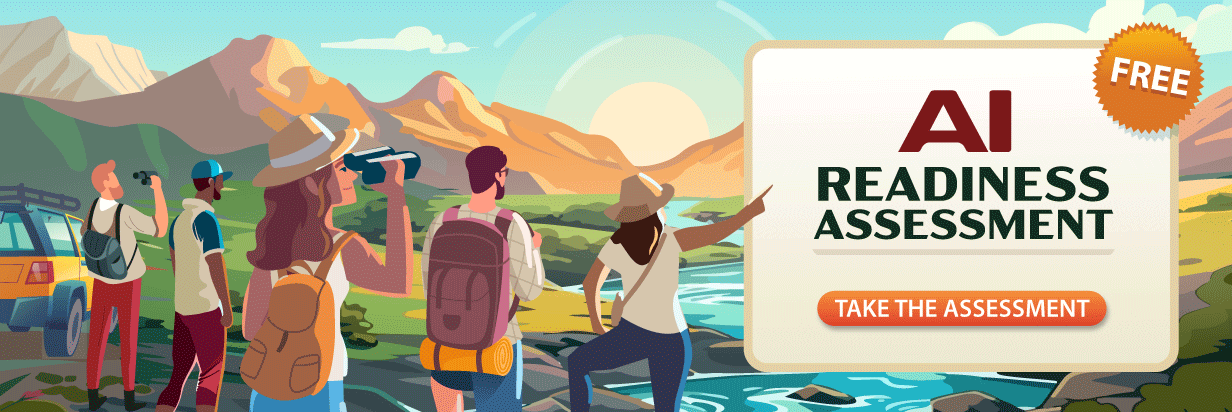Today's Guide to the Marketing Jungle from Social Media Examiner...
presented by 
We're halfway through the week, Pz, how's your marketing strategy holding up? Today's tips and insights will help you fine-tune your approach.
In today's edition:
-
What changed with LinkedIn's algorithm last month, and what to do now
-
A tutorial for thumbnail design and testing
-
Customizing secure AI roles to scale your work
-
🗞️ Industry news from OpenAI, Instagram, and more

The New LinkedIn Algorithm
If you think your LinkedIn posts have been getting fewer views lately, you're not imagining things. The algorithm really did change in July 2025.
Michelle J. Raymond breaks it all down in this episode of her B2B Growth Co podcast.
She recaps what's changed, then dives into three types of content LinkedIn is prioritizing right now and how to turn them into a repeatable strategy that doesn't eat your whole workweek. Watch more here.
A Tutorial for YouTube Thumbnails That Get Clicks
Aesthetic, click-worthy thumbnails aren't just a trend—they're your new low-effort, high-impact marketing weapon. If you've ever felt overwhelmed by trying to make your YouTube thumbnails pop or spent way too long fiddling with fonts and filters, this one's for you.
In this tutorial, Salma Jafri explains why minimal, branded thumbnails are not only in but surprisingly easier to create—yes, even if you're designing on your phone. You'll also learn how she's testing different designs using free YouTube tools.
Plus, she shows you how to use everyday tools, a planner, and even heatmaps to take the guesswork out of your visuals—no designer required. Watch more here.

What Does This Make Possible?
At Social Media Examiner, we operate with a "growth mindset".
This means that anytime something happens—good or bad—we ask the above question and always discover exciting new possibilities.
What about you? Are you looking to discover new possibilities?
If so, then consider attending Social Media Marketing World.
Not only will you discover the latest marketing strategies taught by experts in the industry, but you'll also meet other marketers facing the same challenges and opportunities that you are facing.
Ask yourself this: What does attending Social Media Marketing World make possible for Pz?
I'm ready to discover more and save 50%.

Creating AI Roles to Grow Your Business
Ever feel like your business is stuck in a loop of repetitive tasks and missed opportunities? Do you keep putting off strategic projects because you're buried in day-to-day demands?
This interview walks you through how to create custom AI team members using tools like ChatGPT and Claude. You'll learn how to choose the right roles, match them to the best platforms, write high-impact instructions, and integrate each AI role with your business workflows—securely and professionally.
How to Build Effective AI Role Instructions
Creating powerful AI roles requires more than just describing what you want the AI to do. The quality of your instructions directly impacts the effectiveness of your AI team members, so developing clear, comprehensive guidance is essential.
Start by articulating what you want your AI role to do, even if your initial explanation is messy and incomplete. Most people create unclear instructions initially, which leads to disappointing results. The solution involves a systematic cleanup process.
Begin with your rough concept, even if it's disorganized.
I need a landing page for my upcoming event, AI Marketing Summit 2025. And I want it to be persuasive. My desired outcome is that people register for the event and tell their friends.
While this captures your basic intent, it's not structured well enough to generate optimal results. The next step involves asking ChatGPT to clean up your prompt.
Clean up this prompt: [your rough instructions]
When ChatGPT cleans up your prompt, it transforms your messy ideas into something like: "I need a persuasive, high-converting landing page copy for my upcoming event. The goal is to get people to register immediately and feel excited." This cleaned version captures exactly what you wanted to say, but in a much more effective format.
After cleaning up your basic prompt, you can take it to the next level by creating a mega or supercharged prompt.
Turn this into a supercharged mega prompt.
The mega prompt process expands your cleaned instructions into comprehensive guidance that outlines your objective, provides detailed specifications, and addresses formatting requirements. Instead of a simple paragraph, you'll receive a full page of detailed instructions that cover elements you might not have considered.
For the landing page example, a mega prompt might specify including bonuses, covering the main promise, using specific psychological triggers, adding testimonials, creating urgency, and incorporating other conversion elements. The mega prompt anticipates needs and requirements that significantly improve the final output.
Give Your AI Team Member a Comprehensive Knowledge Base
Upload comprehensive information to your AI's knowledge base to make it truly smart about your business. This data includes your best standard operating procedures, brand guidelines, capability statements, company information, and any other documentation that helps the AI understand your business context.
For social media content creators, include your best-performing content so the AI can analyze what works and create similar high-quality material. For copywriters, provide examples of your most successful copy, brand voice guides, and style guidelines.
The knowledge base serves as the AI's reference library, enabling it to produce work that aligns with your established standards and brand identity. The more relevant information you provide, the better the AI can tailor its outputs to match your specific requirements and maintain consistency across all communications.
Tell Your AI Role Team Member to Use a Sequential Question Design
When designing AI roles that gather information through questions, structure them to ask questions in sequential order rather than overwhelming users with multiple questions at once. Tell ChatGPT explicitly to "ask questions in sequential order" and "don't ask the next question until the previous question is answered."
This approach prevents the frustrating experience of receiving twenty questions to answer simultaneously. Instead, users answer one question at a time, creating a more manageable and user-friendly interaction.
For press release writers, this might mean asking first about the event or announcement, then about the target audience, followed by key benefits, and finally about desired outcomes. Each question builds on the previous answer, creating a logical flow that produces better results.
When users answer these questions, encourage them to provide comprehensive information rather than brief responses. The more context and detail the AI receives, the better its output can be. This is where the following vocal brain dump approach becomes valuable.
Other topics discussed include:
-
How to Choose an AI Role to Support Your Work, With Examples
-
Match Your AI Team Member's Function to ChatGPT or Claude
-
3 Ways to Humanize Your AI Role Team Member
-
Security Tips for Building AI Role Team Members
Today's advice provided with insights from Alicia Lyttle, a featured guest on the AI Explored podcast.
Watch the full interview YouTube
ICYMI: What's YOUR AI Readiness Level, Pz?
Earlier this week we launched our AI Readiness Assessment. It's a free quiz to help marketers like you get ahead with AI.
In just 3 minutes or less you'll discover:
🔥 Your current AI Readiness level
🔥 The advantages and challenges of where you are today
🔥 A personalized 30-day action plan
🔥 Ways to level up fast
Stop guessing what to do next and get a tailored path forward based on where you are today—from your friends at Social Media Examiner.
YES! I'm ready to take my free assessment.

OpenAI Launches GPT‑OSS Models: OpenAI has unveiled GPT‑OSS, its first open-weight model family since GPT‑2, introducing two models—gpt‑oss‑120b and gpt‑oss‑20b—available under an Apache 2.0 license. The larger model runs affordably on a single 80 GB GPU and rivals the performance of OpenAI's o4‑mini across benchmarks in coding, health, and reasoning. The smaller gpt‑oss‑20b operates on edge devices with just 16 GB of RAM, offering low-cost local inference comparable to o3‑mini. Both models support agentic workflows, chain-of-thought reasoning, tool integration (like web search and Python execution), and are fully customizable via the Responses API. These models are now accessible globally through major platforms like Hugging Face, AWS Bedrock and SageMaker, Azure, Databricks, and Ollama, with GPU optimizations delivered in partnership with NVIDIA. OpenAI
Gemini App Launches Custom Illustrated Storybooks with Narration: Google has introduced a new feature in the Gemini app that allows users to create personalized, illustrated storybooks complete with read-aloud narration. By describing a story idea—or uploading personal photos or kids' drawings—users can generate a 10-page book in styles ranging from comic strips to claymation. The tool supports storytelling in over 45 languages and is designed to teach lessons, explain concepts, or bring memories to life. It's now available globally on both desktop and mobile platforms. Google
ElevenLabs Enters AI Music With Commercially Licensed Generator: AI audio company ElevenLabs has launched a music generation tool that it says is cleared for commercial use, expanding its offerings beyond voice and translation AI. To support this claim, ElevenLabs announced licensing deals with Merlin Network and Kobalt Music Group, allowing artists to voluntarily opt in and benefit from revenue sharing. The move follows legal scrutiny of similar AI music startups, such as Suno and Udio, for allegedly using copyrighted material in training. ElevenLabs' early music samples mimic the styles of major artists, prompting ongoing discussion about authenticity and ethical use. TechCrunch
Claude Opus 4.1 Boosts Coding and Reasoning Capabilities: Anthropic has released Claude Opus 4.1, an enhanced version of its flagship model that delivers stronger performance in coding, research, and agentic tasks. With a 74.5% score on SWE-bench Verified and notable gains in code refactoring accuracy, Opus 4.1 is already being adopted by enterprise teams for precision debugging. The model also improves at in-depth research and detailed information tracking. Available to paid users on the Claude platform and major cloud APIs, Opus 4.1 maintains the same pricing as Opus 4. Anthropic
Instagram Rolls Out New Creator Insights Tools: Instagram is enhancing its analytics for creators by replacing the "Accounts Reached" metric with "Viewers," offering a more accurate view count. A new feature in the Followers section highlights which posts and reels are driving the most follower growth. Additionally, creators can now access demographic insights at the individual post level, offering detailed data on who is engaging with specific content. For carousel posts, Instagram will also show which slide a user was viewing when they liked it. Instagram
WhatsApp Rolls Out New Anti-Scam Tools and Bans Millions of Accounts: WhatsApp has introduced a suite of new safety tools to combat the rising threat of messaging scams, including a group safety overview and contextual alerts when messaging unknown contacts. These updates come alongside a major crackdown in which the platform banned over 6.8 million scam-related accounts, many linked to organized criminal operations in Southeast Asia. Working with Meta and OpenAI, WhatsApp also disrupted a scam that spanned platforms like TikTok, Telegram, and ChatGPT. The company is promoting a "Pause, Question, Verify" approach to help users recognize scams, especially those offering fast money or urgent financial demands. WhatsApp
Snapchat Unveils Gen Z Insights to Guide Brand Engagement: Snapchat, in partnership with BBDO NY and market research firm Alter Agents, has released a global study debunking common myths about Gen Z and offering strategic guidance for brands. Based on responses from 6,000 Gen Z social platform users, the research reveals this generation values impact, integrity, and authenticity over traditional status symbols and brand loyalty. It highlights Gen Z's nuanced belief systems, entrepreneurial drive, and openness to legacy brands that engage meaningfully through creators and viral moments. The findings emphasize that a one-size-fits-all approach won't resonate—brands must demonstrate real values and evolve with Gen Z's diverse identities and expectations. Snapchat
YouTube Tests Collaborator Tagging: YouTube has begun testing a new feature that lets creators add collaborators to their videos, enabling content to be recommended to the audiences of each tagged creator. This feature is currently available to a limited group of users, with plans to expand the rollout in the future. YouTube
What Did You Think of Today's Newsletter?
Did You Know?
The original batch of Worcestershire sauce made by Lea and Perrins in the mid-1830s was so unpalatable that it was abandoned in their pharmacy's cellar; after fermenting for 18 months or more, it transformed into the famous sauce, leading to its eventual sale.

Michael Stelzner, Founder and CEO
P.S. Add
michael@socialmediaexaminer.com into your contacts list. Use Gmail?
Go here to add us as a contact.
We publish updates with links for our new posts and content from partners. Your information: Email:
punjabsvera@gmail.com Opted in on: 2022-03-22 16:02:45 UTC.